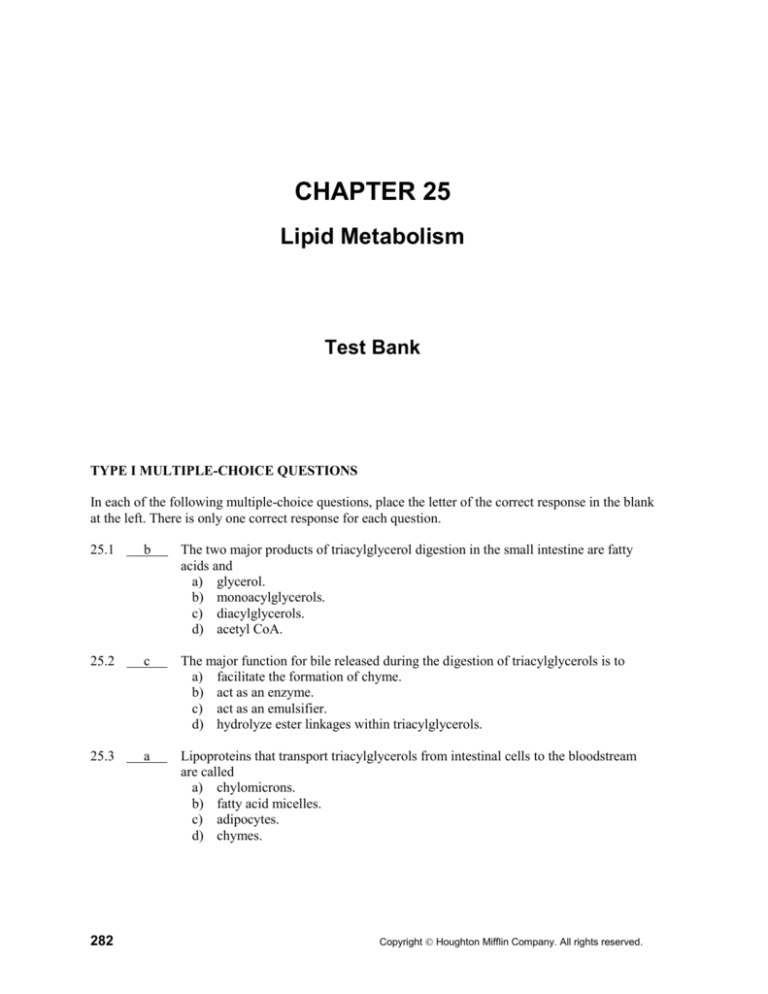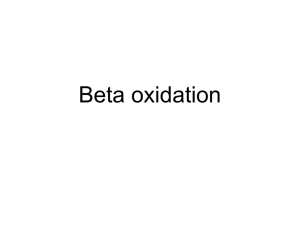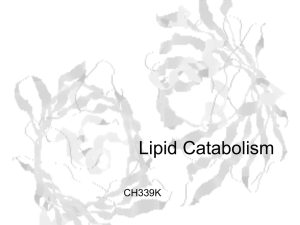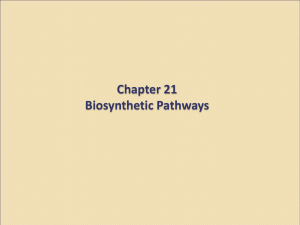
CHAPTER 25
Lipid Metabolism
Test Bank
TYPE I MULTIPLE-CHOICE QUESTIONS
In each of the following multiple-choice questions, place the letter of the correct response in the blank
at the left. There is only one correct response for each question.
25.1
b
The two major products of triacylglycerol digestion in the small intestine are fatty
acids and
a) glycerol.
b) monoacylglycerols.
c) diacylglycerols.
d) acetyl CoA.
25.2
c
The major function for bile released during the digestion of triacylglycerols is to
a) facilitate the formation of chyme.
b) act as an enzyme.
c) act as an emulsifier.
d) hydrolyze ester linkages within triacylglycerols.
25.3
a
Lipoproteins that transport triacylglycerols from intestinal cells to the bloodstream
are called
a) chylomicrons.
b) fatty acid micelles.
c) adipocytes.
d) chymes.
282
Copyright Houghton Mifflin Company. All rights reserved.
Test Bank
Chapter 25: Lipid Metabolism
283
25.4
c
How many times do dietary triacylglycerols undergo hydrolysis before they become
available for use by cells?
a) one
b) two
c) three
d) four
25.5
b
The first stage of glycerol metabolism involves a two-step process in which the
glycerol is converted to
a) glycerol 3-phosphate.
b) dihydroxyacetone phosphate.
c) 3-phosphoglycerate.
d) 2-phosphoglycerate.
25.6
a
Before a fatty acid can enter the fatty acid spiral, it must be activated and then
shuttled across the inner mitochondrial membrane. The activating agent and shuttle
molecule are, respectively,
a) CoA and carnitine.
b) CoA and citrate.
c) acetyl CoA and carnitine.
d) acetyl CoA and citrate.
25.7
b
The correct sequence for the four reactions of the fatty acid spiral in terms of
“functional group acted upon” is
a) alkene, alkane, ketone, 2º alcohol.
b) alkane, alkene, 2º alcohol, ketone.
c) alkane, ketone, 2º alcohol, alkene.
d) ketone, 2º alcohol, alkene, alkane.
25.8
b
The correct sequence for the four reactions of the fatty acid spiral in terms of “type of
reaction occurring” is
a) dehydrogenation, dehydrogenation, hydration, chain cleavage.
b) dehydrogenation, hydration, dehydrogenation, chain cleavage.
c) chain cleavage, hydration, dehydration, dehydrogenation.
d) chain cleavage, dehydration, hydration, dehydration.
25.9
a
[Algorithmic]How many turns of the fatty acid spiral are needed to “process” a C14
fatty acid molecule?
a) six
b) seven
c) twelve
d) fourteen
Copyright Houghton Mifflin Company. All rights reserved.
284
Chapter 25: Lipid Metabolism
Test Bank
Copyright Houghton Mifflin Company. All rights reserved.
Test Bank
Chapter 25: Lipid Metabolism
285
25.10
a
[Algorithmic]How many FADH2 and NADH molecules are produced, respectively,
during one turn of the fatty acid cycle?
a) 1, 1
b) 1, 2
c) 2, 1
d) 1, 3
25.11
a
[Algorithmic]What is the net ATP production for the complete degradation of a C14
fatty acid molecule to CO2 and H2O?
a) 92
b) 106
c) 120
d) 134
25.12
a
The starting material for the process of ketogenesis is
a) acetyl CoA.
b) oxaloacetate.
c) pyruvate.
d) citrate.
25.13
c
Three of the following four compounds are classified as ketone bodies. The one that
is not is
a) acetoacetate.
b) -hydroxybutyrate.
c) acetobutyrate.
d) acetone.
25.14
b
The notation ACP stands for
a) acyl carnitine pyruvate.
b) acyl carrier protein.
c) acetyl carnitine pyruvate.
d) acetyl carrier protein.
25.15
a
The reducing agent needed in the process of lipogenesis is
a) NADPH.
b) NADH.
c) FADH2.
d) ADP.
25.16
d
The carrier of the “two carbon units” used to biosynthesize a fatty acid is
a) acetyl CoA.
b) acetyl ACP.
c) malonyl CoA.
d) malonyl ACP.
Copyright Houghton Mifflin Company. All rights reserved.
286
Chapter 25: Lipid Metabolism
25.17
d
Which of the following processes requires molecular O2 as a reactant?
a) saturated fatty acid degradation to acetyl CoA
b) saturated fatty acid biosynthesis
c) unsaturated fatty acid degradation to acetyl CoA
d) unsaturated fatty acid biosynthesis
25.18
c
[Algorithmic]Which of the following is a correct ordering of cholesterol
intermediates as they are encountered during the biosynthesis of cholesterol?
a) mevalonate, lanosterol, squalene, isopentenyl pyrophosphate
b) lanosterol, squalene, isopentenyl pyrophosphate, mevalonate
c) mevalonate, isopentenyl pyrophosphate, squalene, lanosterol
d) squalene, isopentenyl pyrophosphate, mevalonate, lanosterol
25.19
a
[Algorithmic]Which of the following statements concerning “fuel usage” in the
human body is incorrect?
a) Skeletal muscle in a resting state uses glucose.
b) Cardiac muscle primarily uses fatty acids.
c) Brain function is maintained primarily by glucose.
d) Red blood cells use only glucose.
25.20
b
Which of the following chemical changes is not possible within the human body?
a) pyruvate to acetyl CoA
b) acetyl CoA to pyruvate
c) fatty acid to CO2 and H2O via acetyl CoA, the CAC, and the ETC
d) glucose to fatty acid via acetyl CoA
Test Bank
TYPE II MULTIPLE-CHOICE QUESTIONS
In each of the following multiple-choice questions, place the letter of the correct response in the blank
at the left. There may be more than one correct response (choice d) or no correct response for a
question (choice e).
25.21
b
Which of the following statements concerning digestion of dietary triacylglycerols in
adults is correct?
a) Triacylglycerol digestion begins in the mouth.
b) Triacylglycerol digestion occurs to a small extent (10%) in the stomach.
c) Triacylglycerol digestion occurs only in the small intestine.
d) more than one correct response
e) no correct response
25.22
a
Which of the following is a lipoprotein?
a) chylomicrons
b) fatty acid micelles
c) adipocytes
d) more than one correct response
e) no correct response
Copyright Houghton Mifflin Company. All rights reserved.
Test Bank
Chapter 25: Lipid Metabolism
287
25.23
e
Which of the following compounds is an intermediate in the conversion of glycerol to
dihydroxyacetone phosphate?
a) acetoacetate
b) acetone
c) 3-phosphoglycerate
d) more than one correct response
e) no correct response
25.24
c
The molecule carnitine is involved in
a) glycerol catabolism.
b) fatty acid activation.
c) a shuttle system for acyl CoA.
d) more than one correct response
e) no correct response
25.25
b
Which of the following pairings of terms is correct for reactions in the fatty acid
spiral?
a) alkene functional group; dehydrogenation
b) ketone functional group; chain cleavage
c) alkane functional group; hydration
d) more than one correct response
e) no correct response
25.26
d
One turn of the fatty acid spiral produces
a) an acetyl CoA molecule.
b) two molecules of ATP.
c) an acyl CoA molecule that has been shortened by two carbon atoms.
d) more than one correct response
e) no correct response
25.27
a
Which of the following relationships involving turns of the fatty acid spiral are
correct?
a) 8 turns; 9 acetyl CoA molecules
b) 7 turns; 8 NADH molecules
c) 6 turns; 7 FADH2 molecules
d) more than one correct response
e) no correct response
25.28
d
Which of the following enzymes are required for processing unsaturated fatty acids
through the fatty acid spiral but not for processing saturated fatty acids through the
spiral?
a) an epimerase to change a D-isomer to a L-isomer
b) an isomerase to change a cis (3, 4) bond to a trans (2, 3) bond
c) a transferase to change a -hydroxyacyl CoA to a -hydroxyacyl CoA
d) more than one correct response
e) no correct response
Copyright Houghton Mifflin Company. All rights reserved.
288
Chapter 25: Lipid Metabolism
25.29
e
Which of the following generalizations about “fuel” use in the human body is
incorrect?
a) Skeletal muscle in an active state uses fatty acids.
b) Skeletal muscle in a resting state uses glucose.
c) Heart muscle uses glucose as a preferred fuel.
d) more than one correct response
e) no correct response
25.30
a
Which of the following compounds is a ketone body?
a) acetoacetate
b) oxaloacetate
c) acetyl CoA
d) more than one correct response
e) no correct response
25.31
d
Which of the following statements concerning lipogenesis is correct?
a) It occurs in the cytosol of a cell.
b) It involves a multienzyme complex rather than a series of individual enzymes.
c) It is dependent on the oxidizing agents FAD and NAD+.
d) more than one correct response
e) no correct response
25.32
a
Which of the following statements concerning the chain elongation phase of fatty
acid biosynthesis is correct?
a) Step 1 involves a condensation reaction.
b) Step 2 involves a hydration reaction.
c) Step 3 involves a dehydrogenation reaction.
d) more than one correct response
e) no correct response
25.33
b
Which of the following is an intermediate in the process of lipogenesis?
a) isopentenyl pyrophosphate
b) malonyl ACP
c) oxaloacetate
d) more than one correct response
e) no correct response
25.34
c
Which of the following pairings of information about intermediates in the
biosynthesis of cholesterol is correct?
a) mevalonate; a C5 molecule
b) squalene; a C20 molecule
c) lanosterol; a C30 molecule
d) more than one correct response
e) no correct response
Test Bank
Copyright Houghton Mifflin Company. All rights reserved.
Test Bank
25.35
d
Chapter 25: Lipid Metabolism
289
Which of the following is a possible fate for the acetyl CoA produced from the
degradation of a fatty acid?
a) conversion to pyruvate
b) ketone body formation
c) cholesterol biosynthesis
d) more than one correct response
e) no correct response
MULTIPLE-CHOICE FORMAT TRUE-FALSE QUESTIONS
In each of the following multiple-choice questions, characterize EACH of the three given statements
as being TRUE or FALSE and then indicate the collective true-false status of the statements using the
choices
a) All three statements are true.
b) Two of the three statements are true.
c) Only one of the statements is true.
d) None of the statements is true.
25.36 b - TTF Statements:
(1) Both TAG emulsification and TAG digestion occur in the small intestine.
(2) On an equal-mass basis, fatty acids produce more than twice as much ATP per
gram as carbohydrates (glucose).
(3) The “opposite” processes of lipogenesis and fatty acid oxidation cannot occur
at the same time.
a) All three statements are true.
b) Two of the three statements are true.
c) Only one of the statements is true.
d) None of the statements is true.
25.37 b - TTF Statements:
(1) The fatty acid spiral involves a repetitive series of four reactions.
(2) Triacylglycerol mobilization is a hydrolysis process that occurs in adipose
tissue.
(3) ATP and ACP have similar functions within the human body.
a) All three statements are true.
b) Two of the three statements are true.
c) Only one of the statements is true.
d) None of the statements is true.
Copyright Houghton Mifflin Company. All rights reserved.
290
Chapter 25: Lipid Metabolism
25.38 c - FFT
Test Bank
Statements:
(1) The process by which ketone bodies are produced from acetyl CoA is called
ketosis.
(2) The number of turns of the fatty acid spiral needed to process an eighteen
carbon saturated fatty acid is nine.
(3) Glycerol metabolism involves production of dihydroxyacetone phosphate,
which then enters the glycolysis pathway.
a) All three statements are true.
b) Two of the three statements are true.
c) Only one of the statements is true.
d) None of the statements is true.
25.39 c - TFF Statements:
(1) Initial triacylglycerol digestion usually produces monoacylglycerols rather
than glycerol itself.
(2) Fatty acids are the preferred fuel for “running” the heart (cardiac muscle) and
the brain.
(3) The ketone body acetoacetate is the “parent” compound for the other four
ketone bodies.
a) All three statements are true.
b) Two of the three statements are true.
c) Only one of the statements is true.
d) None of the statements is true.
25.40 c - TFF Statements:
(1) The number of acetyl CoA molecules produced in the fatty acid spiral is equal
to half the number of carbon atoms in the fatty acid that is processed.
(2) A fatty acid micelle is a lipoprotein that transports TAGs from the intestinal
walls to the bloodstream.
(3) Associated with the conversion of acetyl CoA to malonyl CoA, in lipogenesis,
is the production of a carbon dioxide molecule.
a) All three statements are true.
b) Two of the three statements are true.
c) Only one of the statements is true.
d) None of the statements is true.
25.41 a - TTT
Statements:
(1) The products of the first two stages of cholesterol biosynthesis are,
respectively, mevalonate (C6) and isopentenyl pyrophosphate (C5).
(2) Over 90% of total dietary lipids are triacylglycerols.
(3) The activation stage of fatty acid oxidation involves both CoA and ATP.
a) All three statements are true.
b) Two of the three statements are true.
c) Only one of the statements is true.
d) None of the statements is true.
Copyright Houghton Mifflin Company. All rights reserved.
Test Bank
25.42 b - FTT
Chapter 25: Lipid Metabolism
291
Statements:
(1) The functional group change sequence “alkane-alkene-primary alcoholketone” occurs during each turn of the fatty acid spiral.
(2) Squalene and lanosterol, intermediates in cholesterol biosynthesis, contain
more carbon atoms than does cholesterol.
(3) The acetyl CoA needed for lipogenesis is shuttled from mitochondria to the
cytosol via a citrate shuttle.
a) All three statements are true.
b) Two of the three statements are true.
c) Only one of the statements is true.
d) None of the statements is true.
25.43 b - TTF Statements:
(1) When the amount of acetyl CoA is excessive compared with the amount of
oxaloacetate available to react with it, ketone body formation occurs.
(2) The transport stage of fatty acid oxidation involves the shuttle molecule acyl
carnitine.
(3) As a part of digestion of lipids, enzymes in bile help “solubilize” the lipids.
a) All three statements are true.
b) Two of the three statements are true.
c) Only one of the statements is true.
d) None of the statements is true.
25.44 c - TFF Statements:
(1) The ketone body acetoacetate lowers blood pH because of the presence of a
carboxyl (acid) group in its structure.
(2) Two products of the initial turn of the fatty acid spiral are acetyl CoA and a
fatty acid that contains two more carbon atoms than the reactant fatty acid.
(3) Fatty acids produced through lipogenesis cannot contain more than fourteen
carbon atoms.
a) All three statements are true.
b) Two of the three statements are true.
c) Only one of the statements is true.
d) None of the statements is true.
25.45 a - TTT
Statements:
(1) The human body, in the resting state, burns more fat than carbohydrate.
(2) The initial stages of exercise are fueled primarily by glucose.
(3) Statins lower plasma concentrations of LDL by inhibiting cholesterol synthesis
in the liver.
a) All three statements are true.
b) Two of the three statements are true.
c) Only one of the statements is true.
d) None of the statements is true.
Copyright Houghton Mifflin Company. All rights reserved.
292
Chapter 25: Lipid Metabolism
Test Bank
MATCHING QUESTIONS
Identify the step (1 through 4) in a turn of the fatty acid spiral at which each of the compounds on the
left would be encountered as a reactant using the response list on the right. Responses on the right
may be used more than once or need not be used at all.
O
25.46
a
CH3 CH2 CH2 CH2 CH2 C S CoA
OH
25.47
c
CH3 CH2 CH2 CH
O
a)
b)
c)
d)
step 1
step 2
step 3
step 4
CH2 C S CoA
O
25.48
b
CH3 CH
O
25.49
d
CH3 C
OH
25.50
c
CH3 CH
CH
C S CoA
O
CH2 C S CoA
O
CH2 C S CoA
The following questions relate to the degradation of a 16-carbon saturated fatty acid through the fatty
acid spiral to acetyl CoA and the further degradation of the acetyl CoA to carbon dioxide and water.
For each question select an appropriate response from the response list on the right. Responses on the
right may be used more than once or need not be used at all.
25.51
a
How many turns of the fatty acid spiral are needed?
25.52
b
How many acetyl CoA are produced?
25.53
a
How many FADH2 are produced?
25.54
a
How many NADH are produced?
25.55
c
What is the net ATP production for complete degradation of
the fatty acid to CO2 and H2O?
a)
b)
c)
d)
7
8
106
108
Copyright Houghton Mifflin Company. All rights reserved.
Test Bank
Chapter 25: Lipid Metabolism
293
On the left are characteristics of various reactions that occur in the chain elongation phase of fatty
acid biosynthesis. Identify the step (1 through 4) of the chain elongation process to which each
characterization applies using the response list on the right. Responses on the right may be used more
than once or need not be used at all.
25.56
a
Malonyl ACP is a reactant.
25.57
a
CO2 is a product.
25.58
c
A dehydration reaction occurs.
25.59
d
A carbon-carbon double bond is converted to a carboncarbon single bond.
25.60
a
ACP is a product.
a)
b)
c)
d)
step 1
step 2
step 3
step 4
For each of the substances on the left, select from the response list on the right the process with which
it is associated. Responses on the right may be used more than once or need not be used at all.
25.61
b
Acetoacetyl ACP
25.62
c
Carnitine
25.63
d
Dihydroxyacetone phosphate
25.64
d
Glycerol 3-phosphate
25.65
b
Malonyl CoA
a)
b)
c)
d)
ketogenesis
lipogenesis
fatty acid spiral
glycerol degradation
For each of the substances on the left, which are associated with the biosynthesis of cholesterol, select
the number of carbon atoms present in the substance using the response list on the right. Responses
on the right may be used more than once or need not be used at all.
25.66
d
Squalene
25.67
a
Isopentenyl pyrophosphate
25.68
d
Lanosterol
25.69
b
Mevalonate
25.70
c
Cholesterol
Copyright Houghton Mifflin Company. All rights reserved.
a)
b)
c)
d)
C5 molecule
C6 molecule
C27 molecule
C30 molecule










